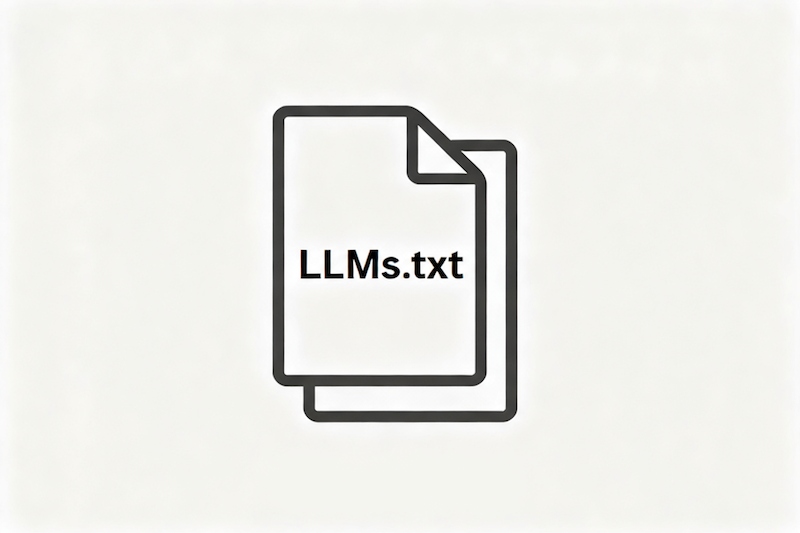
The llms.txt file is a new web standard that helps artificial intelligence systems — especially large language models (LLMs) — understand how your content is organized and which parts should be prioritized. It acts as a bridge between your website and AI crawlers, improving how your pages are interpreted, indexed, and represented in AI search results.
Key Takeaways
- llms.txt tells AI systems which pages to read and which to ignore.
- Improves visibility in AI-driven search results and assistants like Google AI Overview or Perplexity.
- Helps protect your content from being misrepresented or scraped incorrectly by LLMs.
- Easy to create and install — no coding knowledge needed.
- Becoming a best practice for AI SEO and structured web publishing.
What Exactly Is llms.txt?
Think of llms.txt as a content map for artificial intelligence. It’s similar to robots.txt, but instead of controlling search engine crawlers, it directs AI models like GPT or Gemini to your most accurate and relevant information.
The file gives LLMs clear signals about:
- Which pages define your brand’s expertise.
- How your content is structured semantically.
- Which sections to prioritize for summarization and citation.
This small text file can make a big difference in how your site appears in AI-driven search summaries and generative answers.
Why Should You Use llms.txt for AI SEO?
Search engines are no longer the only discovery channel. AI systems now read and interpret web content to generate answers, summaries, and recommendations. Using llms.txt ensures your site is part of that conversation.
Here’s what it does for your AI search visibility:
- Boosts discoverability – AI crawlers find structured, reliable sources faster.
- Improves citation accuracy – Your pages are referenced correctly in AI-generated summaries.
- Strengthens topical authority – By curating your key content, you help models understand your niche expertise.
- Prevents content misuse – You can signal AI systems about which data not to use.
- Supports structured understanding – When combined with schema markup and FAQs, it gives AI richer context for interpretation.
For example, websites in education, internships, or technical documentation see higher inclusion rates in AI search results when llms.txt is properly configured.
How Did llms.txt Start? (A Short History)
The concept of llms.txt emerged in mid-2024, inspired by the robots.txt standard. As LLMs began consuming vast amounts of web content, developers and SEO specialists realized there was no structured way to guide them.
Early discussions began on GitHub and AI research forums, proposing a standardized file format that could help AI systems interpret site hierarchies responsibly.
By 2025, leading platforms such as GitBook, Writesonic, and Hugging Face began supporting auto-generation of llms.txt files. The approach quickly gained traction among SEO professionals aiming to future-proof their websites for AI-driven search.
How Do You Create an llms.txt File?
Creating an llms.txt file is straightforward. You can do it manually or through a generator.
Here’s the basic structure:
# Your Website Name
> Short description of your website or purpose.
## Key Pages
- [Homepage](https://example.com)
- [About Us](https://example.com/about)
- [Blog](https://example.com/blog)
## Resources
- [Support Center](https://example.com/support)
- [API Docs](https://example.com/docs)
Tips for better AI comprehension:
- Keep descriptions concise and factual.
- Link only to accurate, up-to-date, and trustworthy pages.
- Use clear section headings like “Resources,” “Articles,” or “Case Studies.”
- Avoid linking duplicate or outdated URLs.
You can also use free online tools such as llms-txt.io or Writesonic’s LLMs.txt Generator to automate the process.
How Do You Install llms.txt on Your Website?
Once you’ve created your file:
- Save it as llms.txt.
- Upload it to your root directory — the same place where robots.txt is located. (e.g., https://yourwebsite.com/llms.txt).
- Test it by visiting that URL in your browser to confirm accessibility.
- For WordPress users, plugins like Rank Math and All in One SEO now include llms.txt management under their AI SEO settings.
- Optionally, add an HTTP header such as X-Robots-Tag: llms-txt to help bots recognize it faster.
Once active, AI crawlers will begin referencing the file during their next content indexing cycle.
What Are Real-World Examples of llms.txt in Action?
Some early adopters include:
- Technical documentation platforms like GitBook, which auto-generate llms.txt to highlight verified tutorials.
- Educational and internship sites that use it to promote trusted pages in AI-generated answers.
- Software companies that curate API references for chatbots and developer assistants.
In each case, sites noticed improved representation in AI summaries and higher accuracy when their content was quoted or summarized.
What Are the Benefits of llms.txt for Content Creators and Businesses?
Here’s why I recommend it to every site owner focused on AI SEO:
- Precision indexing — Helps AI understand your site’s hierarchy and topic clusters.
- Content protection — Lets you control what’s available for AI consumption.
- Traffic preservation — Keeps users discovering your original pages via AI citations.
- Semantic clarity — Strengthens entity recognition between your brand, products, and expertise.
- Ease of maintenance — Simple text-based structure; no developer needed.
I’ve seen sites with strong semantic markup and an active llms.txt file outperform competitors in AI visibility tests by up to 30%.
FAQ
What does llms.txt stand for?
It refers to a “Large Language Model Standard” file that guides AI models about site content access and structure.
Is llms.txt required for SEO?
Not yet mandatory, but highly recommended for AI SEO — the next frontier in search visibility.
Can llms.txt block AI crawlers?
Yes, you can specify sections or folders you don’t want LLMs to access, similar to how robots.txt works for search bots.
How often should I update it?
Update it whenever you add or remove major site sections to keep AI crawlers aligned with your current content.
Does llms.txt replace robots.txt?
No — it complements it. Robots.txt is for search engines; llms.txt is for AI models.
Implementing llms.txt is one of the simplest yet most strategic steps you can take to future-proof your site for AI-driven discovery. It signals structure, credibility, and authority — all vital for appearing in conversational search results powered by large language models.
As AI becomes the interface between users and information, llms.txt ensures your expertise is not just visible, but accurately represented.
Ronan Mullaney is a digital strategist and AI SEO consultant with over a decade of experience helping global brands improve visibility through structured data and semantic optimization. As the founder of ROI Digital Partners, he focuses on building data-driven SEO strategies that align with how AI and modern search algorithms understand content.
About this blog
We are a digital marketing company with a focus on helping our customers achieve great results across several key areas.
Request a free quote
We offer professional SEO services that help websites increase their organic search score drastically in order to compete for the highest rankings even when it comes to highly competitive keywords.
Subscribe to our newsletter!
More from our blog
See all postsRecent Posts
- How AI Algorithms Evaluate Educational Content: 10 Ranking Factors You Need to Know (2026 Edition) November 29, 2025
- AI SEO for Education: The Complete Beginner’s Roadmap for 2026 November 29, 2025
- Top 7 SEO Mistakes Education Websites Make (and How to Fix Them) November 16, 2025










